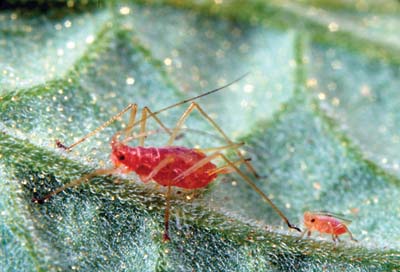To save the Web-optimized images shown below to your hard drive:
|
Click to access Display and Print quality images. |
The primary host plants attacked by the potato aphid are tomato, potato, spinach, lettuce, and corn, though potato aphids feed on essentially all vegetable crops and many weed hosts. Young tissue is commonly damaged first by the potato aphid. Infested leaves will have a distorted appearance with the leaf edges turned downward. Dieback may also occur from the tip downward. Potato aphid is capable of transmitting numerous plant viruses but is not considered to be an efficient vector. Populations of the potato aphid may be determined through sampling techniques such as suction traps, plant traps, leaflet sampling, and visual examination. Foliar insecticides are often applied to suppress potato aphid populations and broad-spectrum insecticides are commonly used. Since they are not important virus vectors, high number of aphids can be tolerated. Soaps, oils, and detergents may be used to control aphid populations. Cultural practices that are commonly used are later planting date, early hilling operations, reflective mulches, sanitation, removal of alternate hosts, and host plant resistance. Naturally occurring insect parasitoids and predators and a fungal disease may reduce aphid populations.
Images
To save the Web-optimized images shown below to your hard drive:

Potato aphid, Macrosiphum euphorbiae, red form, adult and
nymph, on tomato.
(Photographer: P. Choate, University of Florida)
Click to access Display and Print quality images.
|
Click to access Display and Print quality images. |
|
Click to access Display and Print quality images. |
|
|
Click to access Display and Print quality images. |
|
|
Click to access Display and Print quality images. |